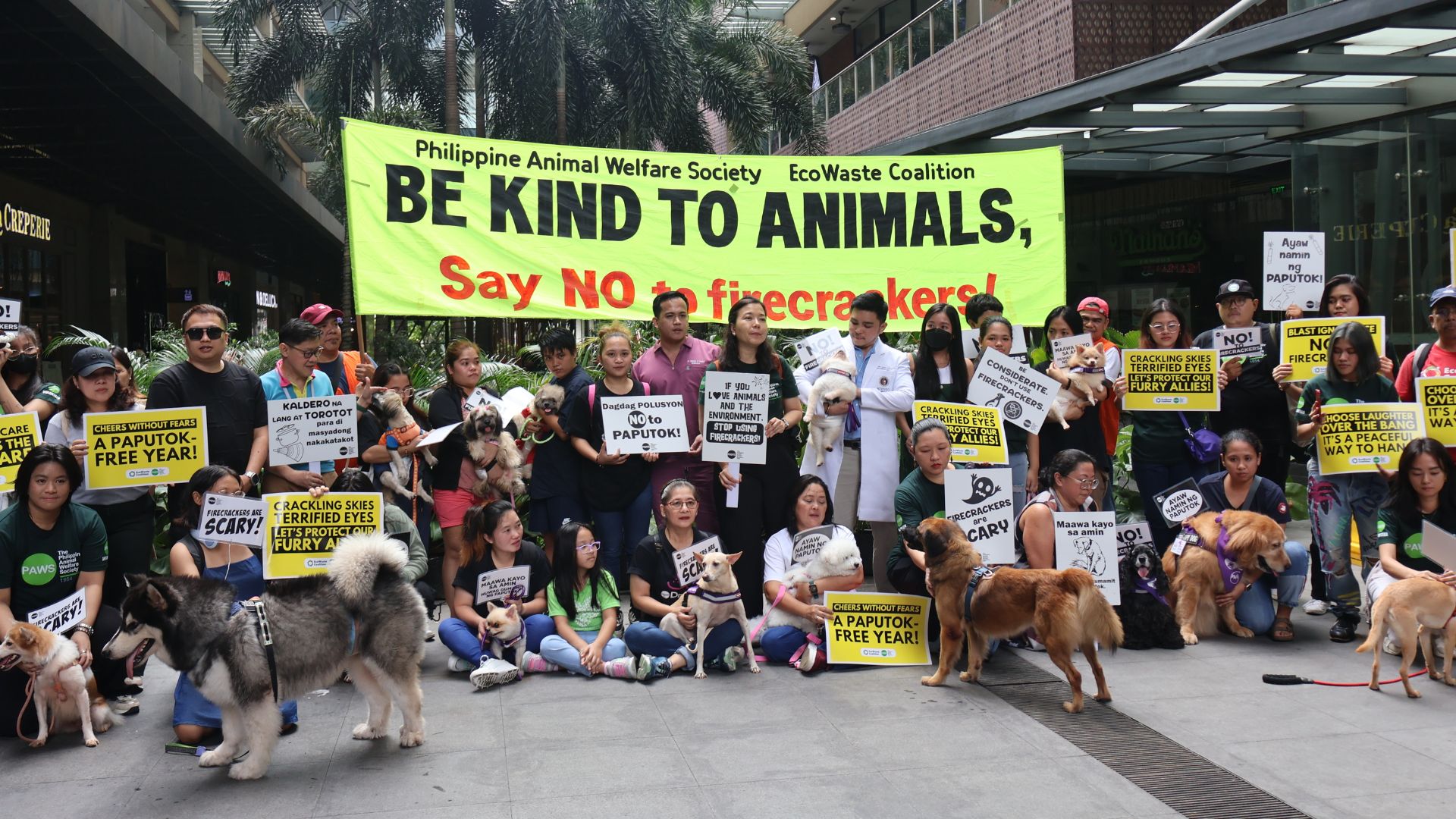As 2024 comes to a close, the Philippine Animal Welfare Society (PAWS) and the EcoWaste Coalition are urging the Filipino people to ditch firecrackers and fireworks to herald the New Year, noting our shared responsibility to protect cats and dogs from fright and trauma and to reduce environmental harm.

A few days before the New Year, the groups organized an event graced by our furry friends to turn the spotlight on how the lighting of firecrackers and fireworks can trigger intense anxiety, discomfort, and physical harm to defenseless dogs and cats while contaminating the environment.

“The deafening explosions caused by firecrackers during the New Year’s Eve revelry can be a terrifying experience for our companion animals—and even more so for the homeless animals on the streets,” said Atty. Anna Cabrera, Executive Director, PAWS. “Since cats and dogs can hear better than humans, the sound of firecrackers and fireworks can cause them severe stress. There are documented cases of dogs who tremble hours after being exposed to the sound of firecrackers.
“In our country, there are dogs still kept in cages outside homes. PAWS advocates for dogs to be kept inside as they are part of the family. However, for the families still who do not share in this advocacy, we plead with them to take their dogs inside at least on New Year’s Eve,” she said. “Outdoor caged or chained dogs are in the worst possible place on New Year’s Eve. They will feel the full impact of ear-splitting explosions and inhale all the fumes. Have mercy on your pets. Keep them inside.”

Just as they are bad for humans, the exposure of cats and dogs to the acrid smoke and odor resulting from the detonation of firecrackers and fireworks can irritate their eyes and lungs and also cause a loss of appetite or upset stomach. Dogs and cats may also ingest parts of pyrotechnic devices, causing abdominal pain, diarrhea, and vomiting.

“The harm caused by firecrackers and fireworks to helpless cats and dogs should discourage the public from using them to usher in 2025,” said Aileen Lucero, National Coordinator, EcoWaste Coalition. “In lieu of firecrackers and fireworks, we appeal to citizens from all walks of life to safely welcome the New Year in a jolly manner using alternative noisemakers that will not put the health of our furry friends and the environment as a whole at risk.”
Environmental health specialist Dr. Geminn Louis Apostol of the Ateneo School of Medicine and Public Health added: “Firecrackers and fireworks release a cocktail of hazardous pollutants that can aggravate the air quality to very unhealthy levels and cause health problems, especially for the most susceptible sectors such as children, pregnant women, the elderly, and those with pre-existing medical conditions.”
Aside from particulate matter (PM), other chemicals detected in the ambient air following the New Year revelry include aluminum, barium, copper, lead, potassium, and strontium, which can affect the health. For example, exposure to PM2.5 can trigger respiratory ailments such as asthma, bronchitis, laryngitis, pneumonia, rhinitis, and sinusitis and also increase the risk of heart arrhythmias and attacks.
To make the countdown to New Year 2025 safe for cats and dogs, PAWS and the EcoWaste Coalition urged the public to be compassionate and heed these reminders:
1. Walk or take your pets for a run or physical activity before it gets dark so they will be tired by nighttime and would be soundly sleeping by the time the revelry begins.
2. Keep pets inside to avoid them becoming stressed or exposed to loud explosions and toxic fumes. Never chain or tie them outside your home—not only during New Year’s Eve; chaining or tethering should never go beyond an hour—as companion animals are meant to share family activities with us inside our home.
3. Escape-proof your home to prevent pets from going out during the revelry. Make sure they have a collar with a tag indicating the pet owner’s details.
4. Make pets pee or poo before the revelry starts, and give them ready access to water.
5. Provide a quiet and safe spot where pets can stay during the revelry; shut the windows, pull the curtains down, and play soft music inside your home.
6. Turn on the television if this will help mask the noise of the firecrackers outside and if you think your pet prefers the sound of the TV over other loud noises.
7. Act as normal and as calm as possible even while the explosions are at their worst so that your pets will take a cue from your behavior—that there is nothing to be alarmed about. Fussing over your pet may have the effect of increasing their tendency to panic.
8. Talk to your veterinarian about giving your pet drops of “Rescue Remedy” or calming edible drops on their favorite treat (available in organic pet supply stores) ahead of time. Buy or make an anxiety vest for dogs that have an extreme fear or trauma response to firecrackers.
9. Keep alcoholic drinks, chocolate, fruit cake, nuts, shopping bags, tobacco products, and cleaning agents out of pet’s reach to prevent choking and poisoning incidents.
10. Give stray animals a safe haven in your garage if you have the space—provide temporary shelter, food, and water, especially during the revelry.




